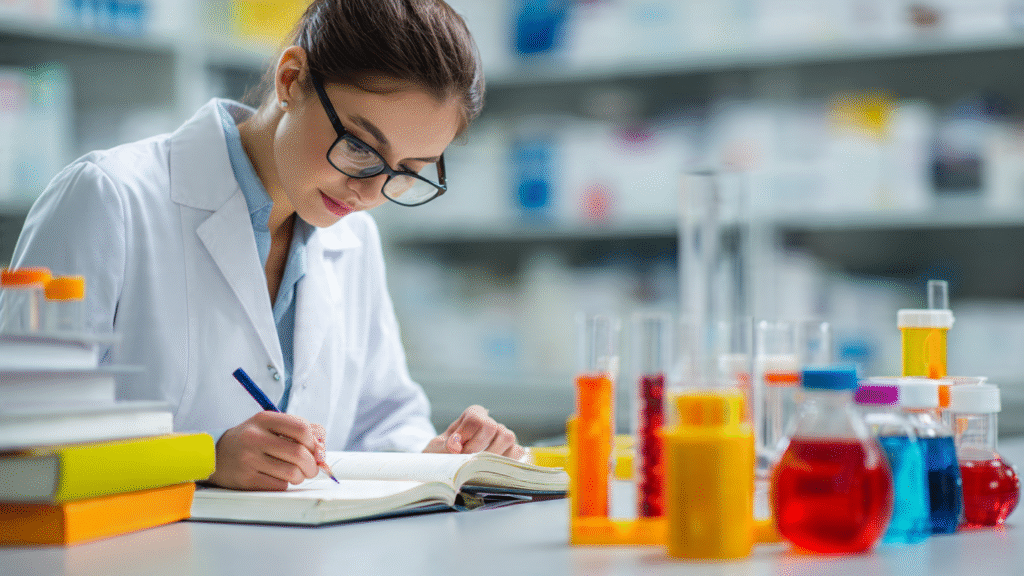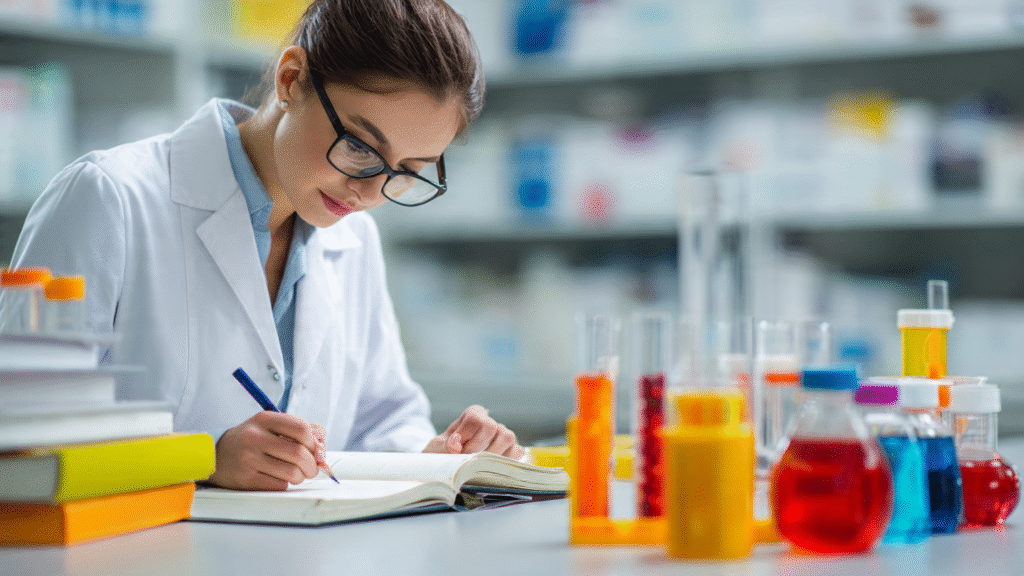
The most common question asked by students considering a pharmacy career is simple: how long does it take to become a pharmacist? The answer is not the same for everyone. The journey usually takes 6 to 8 years and includes undergraduate education, professional pharmacy school, licensing exams, and sometimes residency or fellowship training.
Understanding the pharmacist education requirements and timeline will help you plan better. This guide breaks down the full process, from prerequisites to becoming a licensed pharmacist. It also answers the common questions students search on Google about timelines, degree options, and career steps.
Steps to Become a Pharmacist
Becoming a pharmacist takes planning. You must complete education, training, and licensing in stages.
◉ Undergraduate Prerequisites
Before applying to pharmacy school, you need 2 to 4 years of undergraduate study. Some schools accept students with only prerequisites, while others require a full bachelor’s degree in fields like biology, chemistry, or health sciences.
◉ Pharmacy School (PharmD Program)
The next step is earning a Doctor of Pharmacy (PharmD) degree. This program usually takes 4 years at an accredited pharmacy school. Coursework includes pharmacology, medical chemistry, clinical practice, and patient care.
◉ Licensing Exams
After completing your PharmD, you must pass licensing exams, including the NAPLEX and MPJE, to practice legally.
◉ Residency or Fellowship (Optional)
Some pharmacists extend their training with a residency or fellowship lasting 1–2 years. This step is optional but helpful if you want to specialize in clinical pharmacy or research.
How Many Years in Pharmacy School?
The length of pharmacy school is one of the biggest factors in the timeline.
Standard PharmD program = 4 years
Some combined programs allow you to start directly after high school in a 0–6 or 0–7 track.
If you already completed a bachelor’s degree, you’ll still spend 4 years in pharmacy school. If you enter a 0–6 program, you may finish faster since undergrad and PharmD are combined.
Pharmacist Degree Timeline
To understand the full process, here’s a typical pharmacist degree timeline:
◉ High School (Grades 9–12)
Focus on math, chemistry, and biology to prepare for undergraduate coursework.
◉ Undergraduate Degree or Prerequisites (2–4 years)
Complete pharmacy school admission requirements, such as general chemistry, organic chemistry, microbiology, anatomy, and statistics.
◉ PharmD Program (4 years)
Study advanced subjects in pharmacology, toxicology, drug design, and clinical practice. Gain experience in rotations at hospitals and community pharmacies.
◉ Licensing Exams (3–6 months prep)
Pass the NAPLEX for clinical knowledge and MPJE for legal and regulatory knowledge.
◉ Residency or Fellowship (1–2 years, optional)
Specialize in hospital pharmacy, oncology, pediatrics, or research.
The total average time to become a pharmacist is 6 to 8 years, depending on your path.
Duration of Pharmacist Education
The duration of pharmacist education depends on multiple factors:
◉ Prerequisites for pharmacy school
If you enter a program after 2 years of prerequisites, your timeline will be shorter. If you complete a bachelor’s first, it will be longer.
◉ Full-time vs part-time study
Students who spread coursework over more semesters take longer to graduate.
◉ Residency or fellowship
Specialized training adds an extra 1–2 years.
◉ Country of study
In the USA, the typical time is 6–8 years.
In the UK, the MPharm degree lasts 4 years, plus 1 year of pre-registration training.
In Canada, the PharmD usually takes 6 years total, starting after undergraduate prerequisites.
Pharmacist Training Duration and Licensing
The student to licensed pharmacist journey does not stop at graduation.
◉ Licensing Exams
NAPLEX (North American Pharmacist Licensure Examination): Tests clinical knowledge.
MPJE (Multistate Pharmacy Jurisprudence Examination): Tests legal knowledge.
Exam preparation often takes 3 to 6 months.
◉ Residency and Fellowship
While not required, many students complete postgraduate pharmacy training.
Residency (1–2 years): Hands-on clinical work in hospitals and health systems.
Fellowship (1–2 years): Research training for academic or industry roles.
Pharmacy Career Path Length and Outlook
The pharmacy career path length is long, but the rewards are strong.
Median salary for pharmacists in the USA: about $132,000 annually (BLS data).
Job settings: community pharmacies, hospitals, clinical care, pharmaceutical companies, and government health agencies.
Career growth: The demand for pharmacists is stable, though growth varies by sector.
A pharmacy technician vs pharmacist comparison shows the difference clearly. Pharmacy technicians complete short certification programs in 1–2 years, while pharmacists complete 6–8 years of higher education.
Country Comparisons: How Long It Takes Around the World
The pathway differs slightly depending on where you study:
| Country | Average Timeline | Degree Type | Licensing Step |
|---|---|---|---|
| USA | 6–8 years | Doctor of Pharmacy (PharmD) | NAPLEX + MPJE |
| Canada | 6 years | PharmD | PEBC exams |
| UK | 5 years | MPharm + pre-registration training | GPhC registration |
| Australia | 5–6 years | Bachelor + Masters or PharmD | Pharmacy Board exam |
This shows that time required to complete a pharmacy degree depends on national systems and admission rules.
FAQs: People Also Search on Google
How many years does it take to become a pharmacist in the USA?
It usually takes 6–8 years, including undergraduate prerequisites and a 4-year PharmD program.
Do you need a bachelor’s degree for pharmacy school?
Not always. Some schools admit students after 2 years of prerequisites, while others require a full bachelor’s degree.
How long does a pharmacy residency take?
A pharmacy residency usually takes 1–2 years after completing the PharmD program.
What are the prerequisites for pharmacy school?
Most programs require biology, chemistry, physics, anatomy, and mathematics courses before admission.
How long does pharmacy school take in Canada or the UK?
In Canada, it takes about 6 years in total. In the UK, the MPharm takes 4 years plus 1 year of training.
What is the fastest way to become a pharmacist?
The 0–6 PharmD programs let students start right after high school and finish in about 6 years.
Is pharmacy a good career path?
Yes. Pharmacists earn high salaries, have stable career opportunities, and contribute directly to healthcare.
Conclusion
So, how long does it take to become a pharmacist? The average time is 6 to 8 years, depending on whether you complete a bachelor’s degree first, the structure of your pharmacy school, and whether you pursue postgraduate training.
The main stages are:
◉ Undergraduate prerequisites or bachelor’s degree (2–4 years)
◉ Doctor of Pharmacy (PharmD) program (4 years)
◉ Licensing exams (months of prep)
◉ Optional residency or fellowship (1–2 years)
With dedication and planning, the student to licensed pharmacist journey leads to a respected, well-paid career in healthcare. If you are motivated to help patients and advance in medicine, pharmacy is a career worth the time.
